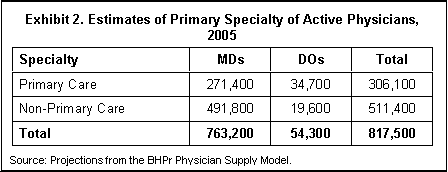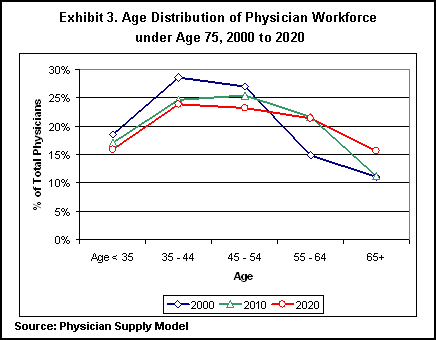|
|
 |
|
Current
Physician Workforce
The
starting point for projecting physician supply is estimating
the size and characteristics of the current physician workforce.
The primary sources for this information are the American
Medical Association (AMA) and the American Osteopathic Association
(AOA). As of the base year (2000), an estimated 756,000
[3]
active physicians under age 75 were practicing in the United
States. Approximately 95 percent are MDs and 5 percent are
DOs. PSM projections suggest that the current number of
active physicians under age 75 (as of 2005) is approximately
817,500. Slightly over one third are generalists (family
practice, general pediatrics or general internal medicine);
the remaining two thirds are specialists (Exhibit 2).
 [D] [D]
Physician
demographics have important supply implications. Physician
age is correlated with retirement probability and annual
hours worked, and a growing proportion of physicians are
nearing historical retirement age as illustrated by the
shifting physician age distribution (Exhibit 3).
 [D]
[D]
Currently,
one in four physicians is female, but two factors are contributing
to a rise in female representation. First, during the past
three decades the proportion of new medical graduates who
are female has risen from 10 percent to close to 50 percent.
Second, the growth in female representation is a relatively
recent phenomenon, and it is predominantly male physicians
who are nearing retirement age. Although one in three active
male physicians is age 55 or older, only one in eight active
female physicians is age 55 or older. Because work and retirement
patterns differ systematically for male and female physicians,
the increasing proportion of physicians who are female has
profound implications for the overall supply of physician
services. Female physicians are more likely than their male
counterparts to choose non-surgical specialties and to spend
fewer hours per year providing patient care. They are also
less likely to work in rural areas, and they tend to retire
slightly earlier. The PSM also tracks primary activity (patient
care or other). An estimated 94 percent of active physicians
are engaged primarily in patient care activities, while
the remaining 6 percent are engaged primarily in non-patient
care activities such as administration, teaching, research,
and others. |